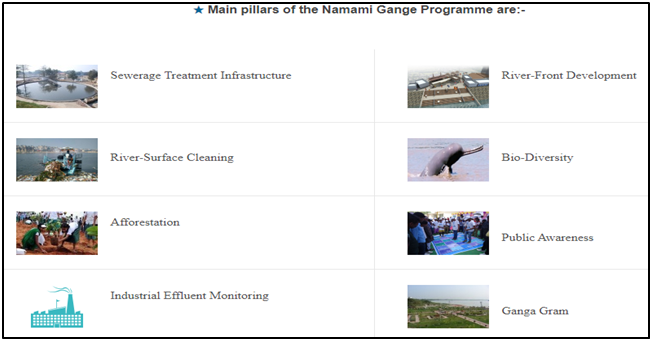Why in News?
The Union Jal Shakti Ministry launched an e-flow ecological monitoring system that allows real-time planning and monitoring of projects, river water quality, and other key parameters.
What’s in Today’s Article?
- What is the Background in which the E-flows Monitoring System Launched?
- What is the E-flows Monitoring System?
- What is the Significance of the E-flows Monitoring System?
- About Namami Gange Programme
What is the Background in which the E-flows Monitoring System Launched?
- The Government of India mandated in 2018 minimum E-flow for various stretches of the Ganga River to be maintained year-round.
- Following this, the National Mission for Clean Ganga (NMCG), an arm of the Jal Shakti Ministry, laid down the flow specifications essential for -
- Preserving the river's ecological balance, safeguarding aquatic life, and
- Ensuring sustainability amidst diverse water usage demands.
- From the upper Ganga Basin to its confluences and beyond, stringent measures are in place to ensure compliance with E-flow norms, benefiting both existing and future projects.
- With monitoring and regulatory mechanisms, Ganga's ecological resilience is being safeguarded for generations to come.
What is the E-flows Monitoring System?
- It has been developed by the NMCG and allows real-time analysis of the water quality of the Ganga, Yamuna, and their tributaries.
- It also allows monitoring of the Namami Gange programme activities at the central level, including -
- Monitoring the performance of Sewage Treatment Plants (STPs), and
- Ensuring that they operate at their rated capacity.
- The Namami Gange programme is a flagship programme of the Ministry that involved cleaning the Ganga and now includes its tributaries.
What is the Significance of the E-flows Monitoring System?
- The E-flow Monitoring System marks a significant step towards ensuring the continuous and sustainable flow of the Ganga River.
- The system will track key parameters such as in-flow, out-flow, and mandated E-flow across 11 projects along the Ganga Mainstream.
About Namami Gange Programme:

- It is an integrated conservation mission, approved as ‘Flagship Programme’ by the Union Government in 2014 with budget outlay of Rs.20,000 Crores.
- It is administered by the Ministry of Jal Shakti's Department of Water Resources, River Development and Ganga Rejuvenation, to accomplish the twin objectives of -
- Effective abatement of pollution,
- Conservation and rejuvenation of National River Ganga.
- The program would be implemented by the National Mission for Clean Ganga (NMCG), and its state counterpart organisations i.e., State Program Management Groups (SPMGs).
- NMCG is the implementation wing of National Ganga Council (NGC), which replaced the National Ganga River Basin Authority.
- NGC was created in 2016 under the River Ganga (Rejuvenation, Protection and Management) Authorities Order, 2016, and is headed by the PM.
- In order to implement the programme, a three-tier mechanism has been proposed for project monitoring comprising of:
- A high-level task force chaired by Cabinet Secretary assisted by NMCG at the national level,
- State level committee chaired by Chief Secretary assisted by SPMG at the state level and
- District level committee chaired by the District Magistrate.
- Its implementation has been divided into -
- Entry-Level Activities (for immediate visible impact),
- Medium-Term Activities (to be implemented within 5 years of time frame) and
- Long-Term Activities (to be implemented within 10 years).









